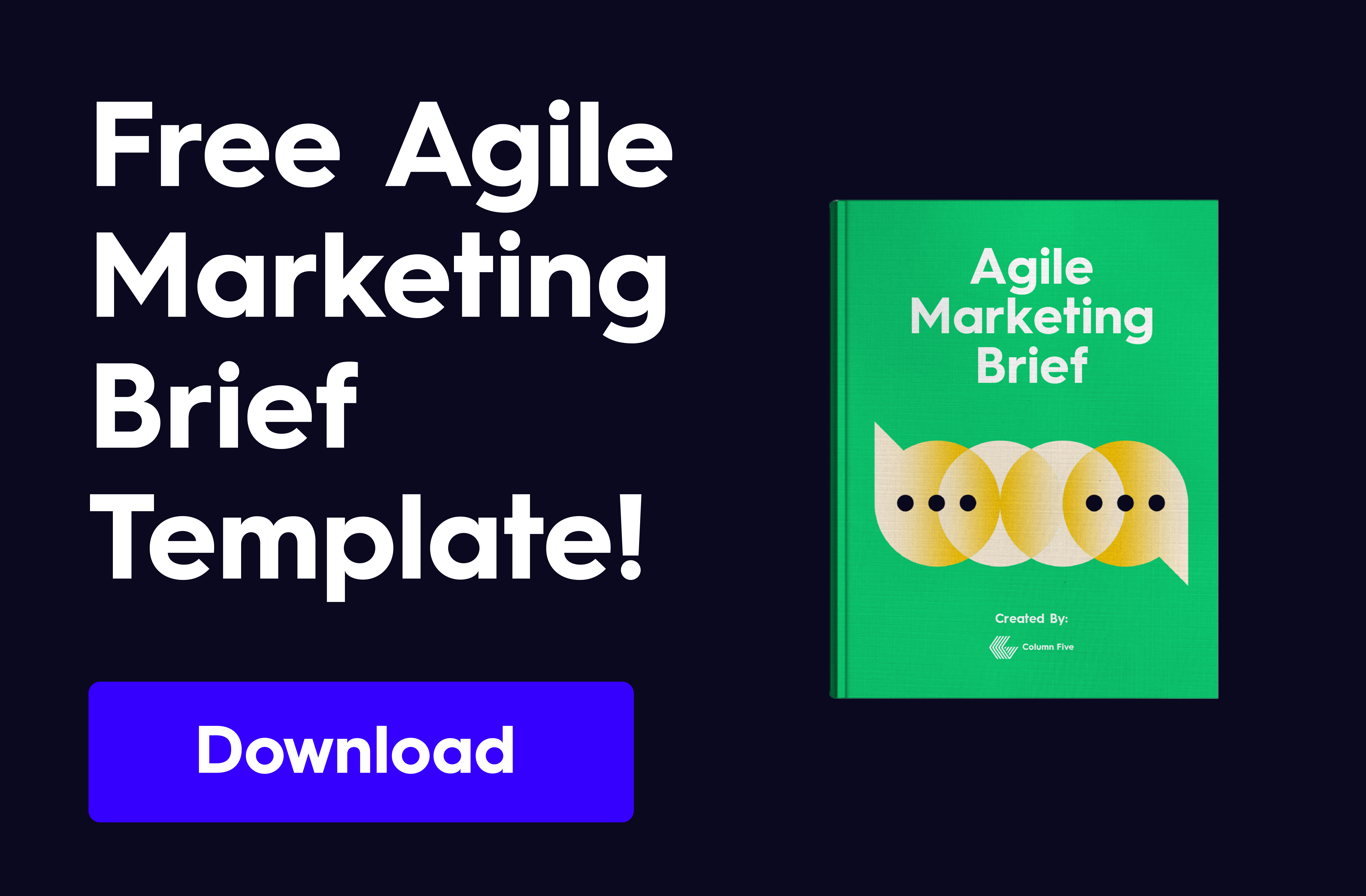For a lot of marketing folks, the past year has been tough. So many rapid advancements happening in parallel to budget cuts means marketers are stretched too thin and asked to do more with less. Big-picture thinking and long-term strategy planning have flown out the window as marketers scramble for immediate results.
We get it. A long-term strategy is important to keep your team aligned, and we’ve spent the last decade fine-tuning our framework to build lasting brands. But we know that in this climate, it’s hard to justify a lengthy, comprehensive effort to reimagine everything if your business is struggling to grow—or simply survive. Right now, you need to move quickly, invest intentionally, and focus on what’s working.
But you also need to adapt and evolve. So, how do you test your ideas effectively, and step towards a larger vision? You need a flexible framework to run lean experiments, get real answers from the market, and even uncover new opportunities to explore in the future. That framework is what we call Agile Content Marketing, a test-and-learn approach that combines first principles thinking, the scientific method, and strategic marketing to answer your biggest questions and guide your next step, one experiment at a time.
If you’re looking for a way to get something new in front of your market (or test a new market), this is the exact framework we use to help our clients get intelligent insights—without a massive investment.
So, grab a seat and your favorite adaptogen-rich beverage as we break down everything you need to know about Agile Content Marketing: what it is, why it’s different, and how to do it. (Or just paste this article into your favorite LLM for a TL;DR summary.)
Let’s dive in.
TOC
- The Biggest Problem Marketers Face
- What Is Agile Content Marketing?
- What Is the Difference Between Agile and Traditional Content Marketing?
- Benefits of Agile Content Marketing
- How to Conduct an Agile Content Marketing Experiment
- How to Improve Going Forward
The Biggest Problem Marketers Face
Why do so many marketers struggle, misfire, and make the same mistakes over and over? Because they don’t have the information they need to make smart decisions.
A strong marketing strategy is built on a foundation of essential truths, including:
- Who your audience is
- What issues they face
- How your product/service/solution addresses those problems
- Why people can believe and trust you’re best suited to solve those problems
To get to these truths, you need to ask the right questions and make decisions based on those answers.
It takes discipline and rigor to question everything. So, say you’ve asked your essential questions and feel confident you have reliable and truthful answers (based on recent results). You know you’ve achieved product/market fit, but you still need to grow. What is the next thing you need to know? Once that question is answered, what is the next thing you need to know? As your marketing organization matures, this series of questions will become more granular and you will inevitably hit a wall with a question you can’t answer. At some point, you need a reliable experiment to get the real answer.
It’s painful and tedious to question fundamental assumptions about your business and marketing, but it’s necessary to understand whether the truths you believe are indeed based on current evidence, or perhaps based on wishful thinking or what was previously true. Here’s the problem: often these questions are “answered” through internal debate and discussion with very little validation from the outside world.
To mitigate risk and adhere to the illusion of “the perfect plan,” marketing teams tend to deploy whatever strategy satisfies the majority of internal stakeholders. Devoid of solid research or hard evidence, these plans often fail because they aren’t informed by deep understanding of market needs and pain points—instead, they’re the lowest common denominator distillation of what the internal team thinks they should do.
What you think works in a conference room often doesn’t work out in the wild.
When you’re catering to opinions, you’re not making decisions grounded in truth. (This isn’t to say there’s no place for instincts; sometimes good instincts can be overshadowed by internal debate, killing off potential winners before they’ve seen the light of day.) But without a reliable testing method, opinions are all we have to work with.
So, what if you could get to validation (or invalidation) of your ideas? What if you could test your hypothesis and use those insights to make smarter decisions about your business? Agile Content Marketing allows you to do exactly that. It lets you build a culture that says, “OK, that’s worth a try,” rather than presuming something works before actually trying it.
So, What Is Agile Content Marketing?
Agile Content Marketing is a way to get quick answers from low-effort experiments. Using the scientific method, you start by identifying a single question you want answered (e.g., is there an audience for this new service? What types of content does my audience prefer? Which creative messaging resonates more?), then deploy a rapid-fire campaign to test the market and gather information in real time.
Experiment. Execute. Optimize.
That is Agile Content Marketing.
These contained experiments help you test your hypotheses and generate timely insights, which you can use to iterate and optimize going forward. This flexible approach eliminates “guessing your way to consensus” and opens the door to building consensus and validating a stronger strategy one test at a time.
Greg Isenberg of Late Checkout is a master of this approach. He’s often assessed whether or not to launch a new company based on engagement with a single tweet about the idea. (I highly recommend checking out their Community Empire, where they show you how to work through their Audience-Community-Product framework for identifying and validating niche business ideas.)
Now, many people smile and nod when we talk about testing and validation: 100% of people agree it’s a good thing, yet only about 4% of people actually do it (based on super unscientific, imaginary data). Why? Because failure is painful, and getting a split-testing tool subscription approved and a pixel added to the website takes 17 years at some companies.
Agile Content Marketing is not for the faint of heart—you go down this road by prioritizing results over being right.
You will have to create in public, test, and iterate your way through evolving hypotheses… and this means intentionally creating space for failure. For many marketers, it feels safer to craft a perfect, meticulous plan behind closed doors, then launch it into the world. It’s the modern content marketing version of “no one gets fired for hiring IBM.” In some ways, it’s a safe approach.
- If that perfect plan actually works (although it so rarely does), you walk away a genius.
- If that perfect plan doesn’t work, there’s always some other factor to blame. (If you’re charismatic, you might even score more budget if you can prove it only failed because you didn’t spend enough money or put enough people on it.)
With Agile Content Marketing, it’s not about making assumptions or trying to achieve a specific result; it’s about testing a specific hypothesis and making decisions based on the answer. Although it can be frustrating, testing is the only way to make your marketing stronger.
Agile Content Marketing is for those who want to marry the everlasting joy of being vision-oriented with the practical benefits of getting started before the vision is perfect.
That’s not to say that Agile Content Marketing is the only way to do successful marketing, but it is a path to get unblocked and figure out what doesn’t work so you can figure out what does.
What Is the Difference Between Agile and Traditional Content Marketing?
Let’s connect this back to what you already know. Is Agile Content Marketing that different from traditional content marketing (i.e. waterfall marketing)? Yes, and no. Both seek to grow brand awareness and market share, but they go about them in different ways—and on different timelines.
- Agile Content Marketing allows for low-risk, scrappy experiments to gather information and adapt strategy.
- Waterfall approaches can be better (or simply necessary) for organizations with large suites of products, who require a complex strategy with more segmentation, coordination, deployment, and oversight.
Ultimately, Agile Content Marketing is about getting quick, definitive answers and iterating strategy from there.
Agile Content Marketing |
Waterfall Marketing |
| Better for… | Better for… |
|
|
Both can be effective in their own ways, but Agile Content Marketing is particularly useful for smaller marketing organizations or innovative teams within large companies that need answers quickly before shifting into scale mode.
The Benefits of Agile Content Marketing
Back to the issue at hand—you need testing because you need specific information to overcome the most common problems in marketing. In the last year, I’m guessing you’ve struggled with at least one (if not all) of these issues:
- Underperforming results
- Stagnation
- Lack of budget
- Lack of resources
- Lack of strategy
- Undifferentiated content
- Inconsistent messaging
- Inaccurate measurement
- Marketplace uncertainty
Agile marketing helps you navigate or overcome all of these pain points in one way or another.
- Efficiency and Cost-Effectiveness: By investing in smaller, targeted experiments, you get quicker insights about what is resonating with your market. This lets you optimize messaging and maximize spend.
- Scale and Impact: Once you prove a successful strategy through a controlled experiment, you can scale confidently to make the most impact.
- Effective Feedback Loops: This approach is designed to create a dynamic feedback loop where each cycle of experimentation brings you closer to an optimal market fit. By continuously running experiments and adapting based on the results, you’re not just learning — you’re actively evolving your brand conversation to meet the market (aka your audience) where it’s at.
- Business Evolution: Beyond immediate market fit, Agile Content Marketing serves as a catalyst for your broader business evolution, as you can use content and marketing innovations as tools for identifying new opportunities and directions.
Ultimately, this is a strategy that embraces change and innovation through experimentation. With an agile and flexible approach, you can unlock the full potential of your marketing efforts and drive your business forward in a way that’s both measured and dynamic.
Agile Content Marketing turns insights into action, and curiosity into competitive advantage.
How to Conduct an Agile Content Marketing Experiment
Now, let’s dive into this roadmap. Our Agile Content Marketing approach spans a 90-day cycle to test each hypothesis.
1) Formulate your hypothesis.
Time required: <15 days
Every experiment seeks to answer a specific question, so start by choosing a single hypothesis that you want to test. This is an opportunity to test your guesses or hunches—assuming they’re grounded in strong research, such as:
- Data Analysis: Review historical data, market trends, and customer behavior analytics to identify patterns and opportunities.
- Customer Insights: Analyze feedback, surveys, and engagement metrics to understand customer needs, preferences, and pain points.
- Competitive Landscape: Evaluate competitors’ strategies and performance to identify gaps and opportunities in the market.
- Innovation Benchmarks: Look at innovations outside your industry that could be adapted to your context, offering fresh angles or solutions.
Your hypothesis should also be:
- Specific: Define what you are testing and expect to change.
- Measurable: Include quantifiable metrics to evaluate success.
- Relevant: Align with broader business goals and customer needs.
- Innovative: Challenge existing assumptions or introduce new concepts.
Based on these inputs, craft a hypothesis that articulates a clear, testable prediction about your experiment (e.g., “Implementing personalized content based on user behavior will increase engagement by X%”).
For example, we used this same process to determine whether or not we should expand our agency services and create a net new AI marketing venture called Copper Key. After diving into market research, customer research, our competitive landscape, etc., we identified key opportunities for this new venture. But we needed a proper test for market demand, so we started with one hypothesis: “Implementing a paid campaign that promotes the benefits of AI to our existing personas will provoke leads.”
2) Design a small-scale experimental campaign.
Time required: 15 days
With your hypothesis in place, you can now design an experiment that isolates the variables in question.
Start by downloading our free Agile Marketing brief to outline your experiment. This should include inputs such as:
- Goal
- Hypothesis
- Audience
- Messaging
- Formats
- Channel
- Measurement
- Budget
- Timeline
Next, create content. Conceive and create lightweight minimum viable products (MVPs) to start, with a focus on enhancing personalized journeys for each individual in your audience. You’ll also want to produce content variations to test your hypotheses across key stages of the buyer journey. These content experiences should speak to your audience’s known pain points and growth opportunities.
To test our theory for Copper Key, we decided to deploy three campaign sprints across LinkedIn, which ran for two weeks each. For each sprint, we decided to A/B test different messaging paired with different visuals to determine which versions emotionally resonated with our audiences.

3) Launch the campaign and observe its performance.
Time required: 60 days
Now it’s time to execute and observe. Implement the experiment thoughtfully, ensuring all systems are in place for accurate data collection. (Make sure your measurement tools are working!)
Monitor the results closely to gather real-time insights and adjust tactics as necessary for clarity and effectiveness. These don’t have to be big changes that impact the flow of your test-and-learn approach but rather small adjustments common to actively managed campaigns.
For our Copper Key campaign sprints, we built check-in points to monitor performance, refine audiences, and adjust spend as relevant.
4) Analyze collected data for optimization opportunities.
Post-experiment, rigorously analyze your collected data against your defined metrics. This will reveal whether your hypothesis was correct and identify areas for improvement or scaling. Then you can bring evidence of what works (and what doesn’t) to cross-functional working groups to spark ideas and get internal buy-in on approaches that are working.
For Copper Key, we intentionally designed a three-phase experiment so that we could use insights to optimize messaging, visuals, and audience.
5) Iterate a new experimental campaign.
Once your first campaign is over, the work has just begun.
In Agile Content Marketing, experimentation unlocks evolution.
Now you can feed insights back into a new hypothesis and continue to iterate and evolve.
- Optimize based on the KPI metrics you defined in your hypothesis. (Any qualitative community feedback is also valuable.)
- Track leads and pipeline by campaign experiment.
- Make better strategic decisions and mitigate long-term risk.
For Copper Key, having optimized each experiment based on learned insights, each campaign sprint outperformed the previous one, and all three campaigns outperformed the industry average of 0.68%* CTR.
- 1st run: 3.54% CTR
- 2nd run: 4.06% CTR
- 3rd run: 5.45% CTR
*Industry Average CTR for Awareness Ad Campaigns on LinkedIn industry (per The Verdict 2.0 Report by Directive)
This low-risk, high-reward experiment gave us valuable insights to guide our larger business decisions—now and in the future.
- We learned what type of messaging and creative drives stronger CTR with the right audience.
- We further refined our audience to identify our specific market.
- Although the response was not enough to warrant a full build-out of a parallel brand, we determined we could successfully merge our AI services into our core business to maximize our offerings.
All in all, this simple experiment saved us significant time, money, and energy, as well as a few internal arguments. Most importantly, the insights we learned from this campaign gave us a deeper understanding of our audience, which will inform future campaigns.
How to Improve Going Forward
Like anything, Agile Content Marketing takes practice, but it will continue to produce better results as you apply insights from previous campaigns to your future campaigns. Still, it’s important to remember that Agile Content Marketing is about agility.
- Don’t get tied to one idea. Not every campaign will be a success. If you hit a dead end, restart with a new hypothesis, or try a dramatically different experiment while keeping the same hypothesis.
- Share your findings. The insights you’re getting can be valuable to both the marketing team, as well as the sales teams. (If you want more ideas to bridge sales and marketing in your buyer journey, try these tips to align your teams.)
- Scale your experiments. If you’re finding success, double down with bigger experiments through expanded content production and promotion.
Above all, remember that fear of failure will always be in the room. And that’s ok. Greet it by name, thank it for trying to protect you from everlasting shame, and move forward knowing you will not die if your idea for reaching a new market with a new message doesn’t work the first time.
P.S. Sometimes it’s a little too scary to face that failure alone. If you need a partner to back you up, see our tips for finding an agency with the right expertise, or find out more about how we work. We’d be happy to help you turn your ship around.






Excellent guide